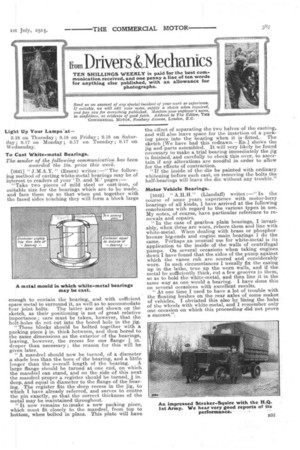Drivers kMechanics
Page 33

If you've noticed an error in this article please click here to report it so we can fix it.
TEN SHILLINGS WEEKLY is paid for the best communication received, and one penny a line of ten words for anything else published, with an allowance for photographs.
Send us an account of any special incident of your work or experience. If suitable, we will edit your notes, suPPly a sketch when required, and pay you for everything published. Mention your employer's name, in confidence, as evidence of good faith. Address to The Editor, THE COMMERCIAL MOTOR, Rose,bery Avenue, London. E.C.
Light Up Your Lamps-at 9.18 on Thursday ; 9.18 on Friday ; 9.18 on Saturday; 9.17 on Monday; 9.17 on Tuesday ; 9.17 on Wednesday.
To Cast White-metal Bearings.
The sender of the following communication has been awarded the 10s. prize this week.
[1641] " J.M.A.Y. " (Essex) writes :—" The following method of casting white-metal bearings may be of interest to readers of your 'D. and M.' pages :
"Take two pieces of mild steel or east-iron, of suitable size for the bearings which are to be made, and face them up so that when put together with the faced sides touching they will form a block large enough to contain the bearing, and with sufficient spare metal to surround it, as well as to accommodate four joint bolts. The latter are not shown on the sketch, as their positioning is not of great relative importance ; care must be taken, however, that the bolt-holes do not cut into the bored hole in the jig. "These blocks should be bolted together with a packing piece in. thick between, and then bored to the same dimensions as the exterior of the bearings, leaving, however, the recess for one flange 1 in. deeper than necessary ; the reason for this will be given later.
"A mandrel should now be turned, of a diameter a shade less than the bore of the bearing, and a little longer than the overall length of the bearing. A large flange should be turned at one end, on which the mandrel can stand, and on the side of this next the mandrel proper a register should be turned, deep, and equal in diameter to the flange of the bearing. The register fits the deep recess in the jig, to which I have already referred, and serves to centre the pin exactly, so that the correct thickness of the metal may be maintained throughout. "It now remains to intake a new packing piece, which must fit closely to the mandrel, from top to bottom, when bolted in place. This plate will have the effect of separating the two halves of the casting, and will also leave space for the insertion of a packing piece into the bearing when it is -fitted., The sketch [We have had this redrawn.—En.1 shoWs the jig and parts assembled. It will very likely be found necessary to make a trial bearing immediately the jig is finished, and carefully to cheek this over, to ascertain if any alterations are needful in order to allow for the effects of contraction.
"If the inside of the die be painted with ordinary whitening before each cast, on removing the bolts the half-bearings will leave the die without any trouble.".
Motor Vehicle Bearings.
[16421 " A.H.H." (Llandaff) writes :—" In the course of some years experience with motor-lorry bearings of all kinds, I have arrived at the following conclusions with regard to the various types in use. My notes, of course, have particular reference to renewals and repairs. "Iii the case of gearbox plain bearings, I invariably, when these are worn, rebore them and line with white-metal. When dealing with brass or phosphorbronze big-ends and engine main bearings I do the same. Perhaps an unusual use for white-metal is its application to the inside of the walls of centrifugal pumps. On several occasions when taking engines down I have found that the sides of the pump against which the vanes rub are scored and considerably worn. In such circumstances I usually fix the easing up in the lathe, true up the worn walls, and if the metal be sufficiently thick, cut a few grooves in them, so as to hold the white-metal, and then line it in the same way as one would. a bearing. I have done this on several occasions with excellent results.
"At one time I used to have a lot of trouble with the floating bushes on the rear axles of some makes of vehicles. I obviated this also by lining the hubs of the wheels with white-metal, and I remember only one occasion on which this proceeding did not prove a success.",


































